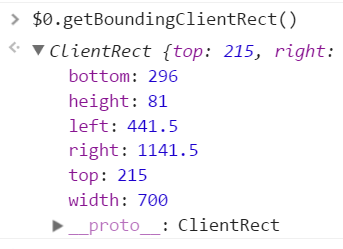
I got stuck on this question during my recent interview, so I took the time to review it carefully.
Node is an interface, called node in Chinese, and many types of DOM elements are Inherited from it, all share the same basic properties and methods. Common Nodes include element, text, attribute, comment, document, etc. (so pay attention to the difference between node and element, element is a type of node).
Node has an attribute nodeType that represents the type of Node. It is an integer, and its values represent the corresponding Node types. The details are as follows:
{
ELEMENT_NODE: 1, // 元素节点
ATTRIBUTE_NODE: 2, // 属性节点
TEXT_NODE: 3, // 文本节点
DATA_SECTION_NODE: 4,
ENTITY_REFERENCE_NODE: 5,
ENTITY_NODE: 6,
PROCESSING_INSTRUCTION_NODE: 7,
COMMENT_NODE: 8, // 注释节点
DOCUMENT_NODE: 9, // 文档
DOCUMENT_TYPE_NODE: 10,
DOCUMENT_FRAGMENT_NODE: 11, // 文档碎片
NOTATION_NODE: 12,
DOCUMENT_POSITION_DISCONNECTED: 1,
DOCUMENT_POSITION_PRECEDING: 2,
DOCUMENT_POSITION_FOLLOWING: 4,
DOCUMENT_POSITION_CONTAINS: 8,
DOCUMENT_POSITION_CONTAINED_BY: 16,
DOCUMENT_POSITION_IMPLEMENTATION_SPECIFIC: 32
}The NodeList object is a collection of nodes, generally returned by Node.childNodes, document.getElementsByName and document.querySelectorAll.
However, it should be noted that the results of NodeList returned by Node.childNodes and document.getElementsByName are real-time (similar to HTMLCollection at this time), while the results returned by document.querySelectorAll are fixed, which is quite special.
For example:
var childNodes = document.body.childNodes; console.log(childNodes.length); // 如果假设结果是“2” document.body.appendChild(document.createElement('p')); console.log(childNodes.length); // 此时的输出是“3”
HTMLCollection is a special NodeList, indicating that it contains several elements (the order of the elements is the order in the document flow ) is a general collection that is updated in real time and automatically updates when the elements it contains change. In addition, it is a pseudo array. If you want to operate them like an array, you need to call it like Array.prototype.slice.call(nodeList, 2).
document.getElementById: Find elements based on ID, case sensitive, if there are multiple results, only the first one will be returned Each;
document.getElementsByClassName: Find elements based on class names. Multiple class names are separated by spaces and an HTMLCollection is returned. Note that compatibility is IE9+ (inclusive). In addition, not only document, other elements also support the getElementsByClassName method;
var elem = document.createElement("p");
elem.id = 'test';
elem.style = 'color: red';
elem.innerHTML = '我是新创建的节点';
document.body.appendChild(elem);The element created through createElement does not belong to the document object, it is just created and not added to the html document, you need to call methods such as appendChild or insertBefore to add it to the HTML document.
createTextNodevar node = document.createTextNode("我是文本节点");
document.body.appendChild(node);var from = document.getElementById("test");
var clone = from.cloneNode(true);
clone.id = "test2";
document.body.appendChild(clone);Cloning a node will not clone the event, unless the event is bound using
using addEventListener and node.onclick= Anything bound using xxx; will not be copied. createDocumentFragmentSuppose there is a question that requires adding 10,000 li to ul. We first use the simplest method of splicing strings to achieve it:
<ul id="ul"></ul>
<script>
(function()
{
var start = Date.now();
var str = '';
for(var i=0; i<10000; i++)
{
str += '<li>第'+i+'个子节点</li>';
}
document.getElementById('ul').innerHTML = str;
console.log('耗时:'+(Date.now()-start)+'毫秒'); // 44毫秒
})();
</script>Then change to the append method one by one. Needless to say, This method is definitely inefficient:
<ul id="ul"></ul>
<script>
(function()
{
var start = Date.now();
var str = '', li;
var ul = document.getElementById('ul');
for(var i=0; i<10000; i++)
{
li = document.createElement('li');
li.textContent = '第'+i+'个子节点';
ul.appendChild(li);
}
console.log('耗时:'+(Date.now()-start)+'毫秒'); // 82毫秒
})();
</script>Finally, try the document fragmentation method. It is foreseeable that this method is definitely much better than the second method, but it should not be as fast as the first one:
<ul id="ul"></ul>
<script>
(function()
{
var start = Date.now();
var str = '', li;
var ul = document.getElementById('ul');
var fragment = document.createDocumentFragment();
for(var i=0; i<10000; i++)
{
li = document.createElement('li');
li.textContent = '第'+i+'个子节点';
fragment.appendChild(li);
}
ul.appendChild(fragment);
console.log('耗时:'+(Date.now()-start)+'毫秒'); // 63毫秒
})();
</script>parent.appendChild(child);
It will append the child to the end of the parent's child node. In addition, if the added node is a node that exists in a page, the node will be added to a new location after execution, and the node will be removed from its original location, which means that there will not be two nodes at the same time. on the page and its events remain.
insertBeforeparentNode.insertBefore(newNode, refNode);
这个API个人觉得设置的非常不合理,因为插入节点只需要知道newNode和refNode就可以了,parentNode是多余的,所以jQuery封装的API就比较好:
newNode.insertBefore(refNode); // 如 $("p").insertBefore("#foo");所以切记不要把这个原生API和jQuery的API使用方法搞混了!为了加深理解,这里写一个简单的例子:
<p id="parent">
我是父节点
<p id="child">
我是旧的子节点
</p>
</p>
<input type="button" id="insertNode" value="插入节点" />
<script>
var parent = document.getElementById("parent");
var child = document.getElementById("child");
document.getElementById("insertNode").addEventListener('click', function()
{
var newNode = document.createElement("p");
newNode.textContent = "我是新节点";
parent.insertBefore(newNode, child);
}, false);
</script>关于第二个参数:
refNode是必传的,如果不传该参数会报错;
如果refNode是undefined或null,则insertBefore会将节点添加到末尾;
removeChild用于删除指定的子节点并返回子节点,语法:
var deletedChild = parent.removeChild(node);
deletedChild指向被删除节点的引用,它仍然存在于内存中,可以对其进行下一步操作。另外,如果被删除的节点不是其子节点,则将会报错。一般删除节点都是这么删的:
function removeNode(node)
{
if(!node) return;
if(node.parentNode) node.parentNode.removeChild(node);
}replaceChild用于将一个节点替换另一个节点,语法:
parent.replaceChild(newChild, oldChild);
DOM中的节点相互之间存在着各种各样的关系,如父子关系,兄弟关系等。
parentNode :每个节点都有一个parentNode属性,它表示元素的父节点。Element的父节点可能是Element,Document或DocumentFragment;
parentElement :返回元素的父元素节点,与parentNode的区别在于,其父节点必须是一个Element元素,如果不是,则返回null;
children :返回一个实时的 HTMLCollection ,子节点都是Element,IE9以下浏览器不支持;
childNodes :返回一个实时的 NodeList ,表示元素的子节点列表,注意子节点可能包含文本节点、注释节点等;
firstChild :返回第一个子节点,不存在返回null,与之相对应的还有一个 firstElementChild ;
lastChild :返回最后一个子节点,不存在返回null,与之相对应的还有一个 lastElementChild ;
previousSibling :节点的前一个节点,如果不存在则返回null。注意有可能拿到的节点是文本节点或注释节点,与预期的不符,要进行处理一下。
nextSibling :节点的后一个节点,如果不存在则返回null。注意有可能拿到的节点是文本节点,与预期的不符,要进行处理一下。
previousElementSibling :返回前一个元素节点,前一个节点必须是Element,注意IE9以下浏览器不支持。
nextElementSibling :返回后一个元素节点,后一个节点必须是Element,注意IE9以下浏览器不支持。
给元素设置属性:
element.setAttribute(name, value);
其中name是特性名,value是特性值。如果元素不包含该特性,则会创建该特性并赋值。
getAttribute返回指定的特性名相应的特性值,如果不存在,则返回null:
var value = element.getAttribute("id");elem.style.color = 'red'; elem.style.setProperty('font-size', '16px'); elem.style.removeProperty('color');
var style = document.createElement('style');
style.innerHTML = 'body{color:red} #top:hover{background-color: red;color: white;}';
document.head.appendChild(style);通过 element.sytle.xxx 只能获取到内联样式,借助 window.getComputedStyle 可以获取应用到元素上的所有样式,IE8或更低版本不支持此方法。
var style = window.getComputedStyle(element[, pseudoElt]);
getBoundingClientRect 用来返回元素的大小以及相对于浏览器可视窗口的位置,用法如下:
var clientRect = element.getBoundingClientRect();
clientRect是一个 DOMRect 对象,包含width、height、left、top、right、bottom,它是相对于窗口顶部而不是文档顶部,滚动页面时它们的值是会发生变化的。

以上就是JavaScript常见原生DOM操作API总结的内容,更多相关内容请关注PHP中文网(www.php.cn)!




